Marine Glossary
An area of the ocean from approximately 10,000 to 20,000 feet (3,000 to 6,000) beneath the surface.
A highly variable group of photosynthetic organisms that occur in moist soils or aquatic environments . Algae can be single-celled organisms or very large multi-celled forms like giant kelp.
A excessive growth of algae, usually as a result of excess nutrients in the water. Algal blooms can be harmful, due to reduced amounts of oxygen in the water as the excessive amounts of algae die, see red tides.
A substance created by the digestive system of sperm whales. Scientists suggest that this substance may be created to help ease the passage of the hard parts of food that they have eaten. Ambergris is either excreted or regurgitated by whales and can be found along the sea shore or floating in the ocean in large chunks up to 100 pounds. Historically ambergris has been used in perfumes.
A patch of white shaped like an anchor and located on the chest and belly of pilot whales.
An opening at the end of the digestive tract of an animal. Solid wastes are expelled through this opening.
Anything pertaining to water; an animal that lives in the water (fresh, brackish, or salt).
This is the genus for the giant squids. Giant squids are large cephalopods. Large giant squids can reach up to 46 feet (14 meters) long. An average giant squid can be 20 to 40 feet (6-12 meters) in length. Giant squid are eaten by sperm whales.
The area in the extreme north of the northern hemisphere. The southern limit to the Artic is the Artic circle. Parts of the Arctic Ocean are covered in ice all year.
One of the largest animal phyla. Arthropods typically have jointed armor-like external protection (exoskeletons) and segmented appendages. Arthropods include insects and crustaceans.
B
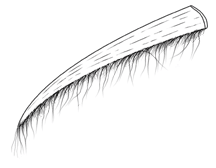 Plates of hard, flexible keratin (the same material that makes up our fingernails) with flexible fringes that hang from the upper jaws of certain types of whales. Baleen whales take large amounts of water in their mouths. After closing their mouth, the whales to push water through the plates and the food gets trapped on the baleen. These plates are referred to as 'whalebone' by the early whalers.
Plates of hard, flexible keratin (the same material that makes up our fingernails) with flexible fringes that hang from the upper jaws of certain types of whales. Baleen whales take large amounts of water in their mouths. After closing their mouth, the whales to push water through the plates and the food gets trapped on the baleen. These plates are referred to as 'whalebone' by the early whalers.Members of the Mysticeti suborder of Cetacea that have baleen plates used for straining food from water.
 A marine crustacean with an external hard shell. These animals attach themselves to many types of surfaces including parts of whales and other large marine mammals. Photo: Aleria Jensen, NOAA/NMFS/AKFSC.
A marine crustacean with an external hard shell. These animals attach themselves to many types of surfaces including parts of whales and other large marine mammals. Photo: Aleria Jensen, NOAA/NMFS/AKFSC.When a marine mammal becomes stranded on land (also termed stranding).
 In some dolphins and whales, this refers to an elongated area of the head that include the mouth and jaws.
In some dolphins and whales, this refers to an elongated area of the head that include the mouth and jaws.Members of the family Ziphiidae. Beaked whales have long jaws that look like a beak. Beaked whales are in the suborder of cetaceans that are the toothed whales (Odontoceti).
The underside of an animal's body.
Organisms that feed at the bottom of a body of water (floor of the ocean).
The area at the bottom of a body of water. It includes the surface and subsurface of the bottom.
Organisms that live at the bottom of a body of water.
See algal bloom. An excessive growth of algae, usually as a result of an abundance of nutrients in the water. Algal blooms can be harmful, because of reduced amounts of oxygen in the water as the algae die, see red tides.
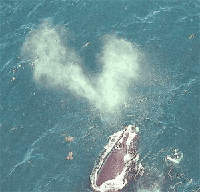
" />When a cetacean forces air out of its blowhole. This is commonly visible from a distance as a spout of white spray. The image shows the "V""-shaped blow of a right whale. Photo: NOAA Northeast Fisheries Science Center."
 The hole through which cetaceans breath. The blowholes are found on the top of their body and allow them stay almost totally underwater while take air in and out through the hole. Because they tend to push water surrounding the blowhole up and out of the way when they expel air, it looks like the whales are expelling water.
The hole through which cetaceans breath. The blowholes are found on the top of their body and allow them stay almost totally underwater while take air in and out through the hole. Because they tend to push water surrounding the blowhole up and out of the way when they expel air, it looks like the whales are expelling water.A layer of fat found on whales, dophlins, porpoises, seals and walruses. During the 1700's-1900's, blubber was harvested from these animals for making lamp oil.
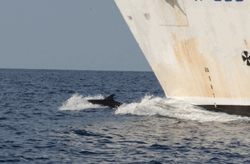 (bow riding) Bow riding is a behavior where dolphins ride or surf the water that is pushed up in front of a moving boat or a large whale. The movement of water creates a pressure wave. It is unknown if there is any reason for this behavior or if the dolphins are just playing around. Image by Wayne Hoggard NOAA/NMFS/SEFSC.
(bow riding) Bow riding is a behavior where dolphins ride or surf the water that is pushed up in front of a moving boat or a large whale. The movement of water creates a pressure wave. It is unknown if there is any reason for this behavior or if the dolphins are just playing around. Image by Wayne Hoggard NOAA/NMFS/SEFSC.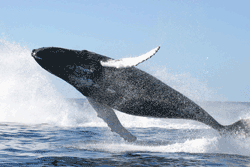 A behavior of whales and dolphins where they jump completely or partially out of the water and land on their belly, sides, or back making a large splash. Photo: NOAA.
A behavior of whales and dolphins where they jump completely or partially out of the water and land on their belly, sides, or back making a large splash. Photo: NOAA.A method of feeding used by a group of humpback whales, where the whales release nets or curtains of bubbles around a school of fish in an attempt to move them into a smaller area. When the bubble-net is finished, the whales swim up through the circle of bubble and swallow the fish.
A male whale.
Any species of animal caught accidentally by commerical fisherman. These animals are not the target of the fishery or are not the appropriate size of the target species. Many cetacean species have been killed because they have been by-catch in the commercial fishing industry.
C
A young cetacean or marine mammal that is dependent on its mother for food and care.
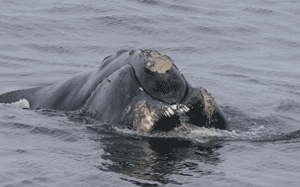 The thickened skin, or calluses, found on the heads of the right whales (Eubalaena sp.). These patches appear light gray to white compared to the dark gray skin of the whales. These callosities are inhabited by colonies of whale lice. Photo: NOAA.
The thickened skin, or calluses, found on the heads of the right whales (Eubalaena sp.). These patches appear light gray to white compared to the dark gray skin of the whales. These callosities are inhabited by colonies of whale lice. Photo: NOAA.A pattern of color on the back of some whales and dolphins that extends from its head down its neck/back toward its dorsal fin and sometimes onto its sides.
A typically hard external skeleton that protects an organism.
An animal that primarily eats meat.
See carnivore
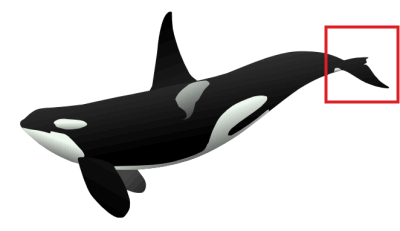 The area near and including the tail of marine mammals.
The area near and including the tail of marine mammals.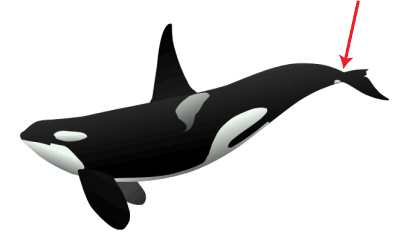 On a cetacean, the generally narrow area found close to the tail, also referred to as the tail stock.
On a cetacean, the generally narrow area found close to the tail, also referred to as the tail stock.Any animal belonging to the Class Cephalopoda. This group is characterized by animals with tentacles and large eyes and includes squid and octopi.
The order of marine mammals that includes whales, dolphins, and porpoises.
The group of marine mammals that belong to the order Cetacea, whales, dolphins, and porpoises.
A physical attribute of an animal, such as hair, feathers, webbed feet, color pattern, or song.
A higher taxonomic category for a group of related animals or plants which share common characteristics. This category is more specific than a phylum and broader than an order. For more information see the classification of animals.
The ordering of organisms into groups on the basis of their relationships. For more information see the classification of animals.
A series of clicks, or pulsed sounds, created by echolocating whales and dolphins.
Cone-shaped teeth. Members of the family Delphinidae have conical shaped teeth.
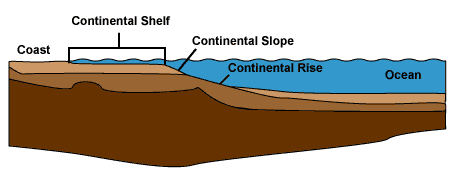 The area of shallow ocean that borders each continent. These areas were dry and exposed during glaciation. Because these areas are shallow (< 650 ft or 200 m) and have good light, they have a lot of life. The area where the continental shelf ends is marked by the 100-fathom line (image by Office of Naval Research).
The area of shallow ocean that borders each continent. These areas were dry and exposed during glaciation. Because these areas are shallow (< 650 ft or 200 m) and have good light, they have a lot of life. The area where the continental shelf ends is marked by the 100-fathom line (image by Office of Naval Research). 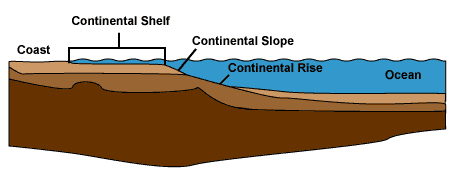 The area of ocean where the continental shelf becomes steeper and drops off to deeper waters of the ocean (image by Office of Naval Research).
The area of ocean where the continental shelf becomes steeper and drops off to deeper waters of the ocean (image by Office of Naval Research).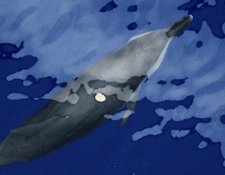 A shark species, Isistius brasiliensis, that feeds on many marine mammal species. It grabs a round chunk of skin, blubber, and muscle from its victim. This injury leaves a round scar on the animal after it is healed (Image of damage by a cookie cutter shark by Wayne Hoggard NOAA/NMFS/SEFSC).
A shark species, Isistius brasiliensis, that feeds on many marine mammal species. It grabs a round chunk of skin, blubber, and muscle from its victim. This injury leaves a round scar on the animal after it is healed (Image of damage by a cookie cutter shark by Wayne Hoggard NOAA/NMFS/SEFSC).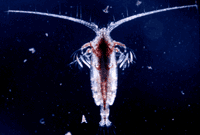 A group of small crustaceans living in almost all bodies of fresh and salt water. Copepods are a common food source for species of baleen whales. Photo: NOAA Central Library Historical Fisheries Collection.
A group of small crustaceans living in almost all bodies of fresh and salt water. Copepods are a common food source for species of baleen whales. Photo: NOAA Central Library Historical Fisheries Collection.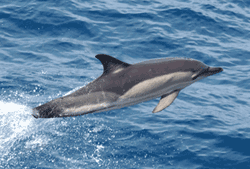 Counter shading is a pattern of color, dark on top and lighter below, found on animals allows them to hide more easily from predators or to hide as they are hunting prey. Photo: NOAA NMFS .
Counter shading is a pattern of color, dark on top and lighter below, found on animals allows them to hide more easily from predators or to hide as they are hunting prey. Photo: NOAA NMFS .Countercurrent heat exchange is used by whales and dolphins to keep the main parts of their body warm. The veins and arteries that go out to a cetaceans's flipper are close to one another. The arteries carry warm blood from the body of the animal out to the flipper. Before reaching the flipper, the heat from the warm artery heats up the blood in the cold vein, which helps keep heat within an animal's body.
A female whale.
A class that includes crabs, shrimps, and crayfishes. They have segmented bodies with a head, thorax, and abdomen.
A group of invertebrates (animals having no internal skeleton) that have a segmented body, an exoskeleton (a hard outer covering), and breathe through gills. Crustaceans include animals like shrimp, lobsters, krill, barnacles, crabs, and crayfish.
Serving to conceal; describes the form or coloring of animals that hides them from potential predators. Camouflage is cryptic coloration.
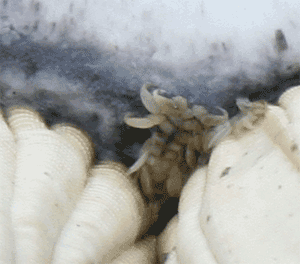 Members of the family Cyamidae, also called whale lice, these tiny crustaceans live on whales, dolphins, and porpoises. Whale lice eat the skin of the whales on which they live. Photo: Aleria Jensen, NOAA/NMFS/AKFSC.
Members of the family Cyamidae, also called whale lice, these tiny crustaceans live on whales, dolphins, and porpoises. Whale lice eat the skin of the whales on which they live. Photo: Aleria Jensen, NOAA/NMFS/AKFSC.Members of the family Delphinidae, the marine or ocean dolphins.
The demersal zone is the area of the ocean that is part of the water column just above the ocean floor.
A group of single-celled algae. Diatoms are a common group found in phytoplankton
Having more than one color or body form. Dimorphism can include differences between sexes, or between color phases within the same sex. See "sexual dimorphism."
When there are differences in two forms of the same species, see sexual dimorphism.
Referring to the back or top of an animal.
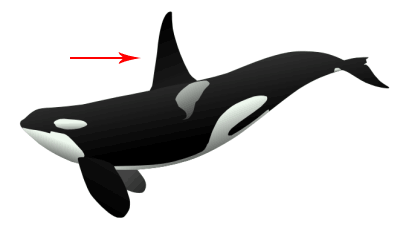 The fin on the back, or top, of cetaceans and fish.
The fin on the back, or top, of cetaceans and fish.See dorsal
See dorsal
E
A method used by some mammals for locating prey. This method involves the animal emitting a sonic sound, the sound bounces off objects in the distance and come back to them as an echo. The amount of time it takes an echo to return helps the animal know the object's shape, size, and distance.
The study of relationships between living organisms and their environment.
A "cold-blooded" animal. Animals such as amphibians and reptiles that cannot regulate their body temperature by internal means, so their body temperature is essentially the same as that of their surrounding environment. See also "poikilotherm."
A species that is facing extinction. For more information see the conservation status.
A species that is native to an area or region.
A "warm-blooded" animal. birds and mammals can internally regulate their body temperature so that it remains fairly constant even when the surrounding environment is cooler or warmer.
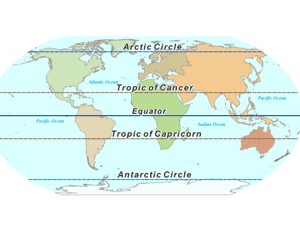 An imaginary line that divides the Earth equally in two. This line is the same distance away from both the North Pole and the South Pole.
An imaginary line that divides the Earth equally in two. This line is the same distance away from both the North Pole and the South Pole.The transition zone between ocean salt-water and riverine fresh-water. These areas are nutrient rich and provide habitat for certain life stages of many species of fish, crustaceans, and other animal species.
A family of small crustaceans that look like shrimp, referred to as krill. They are a common food item for many cetaceans.
When all members of a particular species have died. For more information see the conservation status.
See extinct
See extripated
The complete disappearance of a species from a specific geographic region or part of its historic range.
See extirpated.
F
 Having a sickle or curved shape.
Having a sickle or curved shape.A higher taxonomic category for a group of related animals or plants which share common characteristics. This category is more specific than an order and broader than a genus. For more information see the classification of animals.
A fathom is a unit to measure depth of water. One fathom is equal to six feet (1.8 m). Originally it was the distance between a mans outstretched arms.
Any animal that feeds by straining prey items over some structure that allows the food to captured and eaten. Baleen whales are filter feeders.
A paddle or triangular-shaped limb of marine mammals. The pectoral fins of these animals are commonly referred to as flippers.
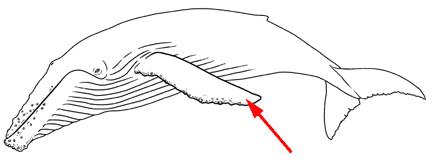 The limbs or fins found near the head of marine mammals.
The limbs or fins found near the head of marine mammals.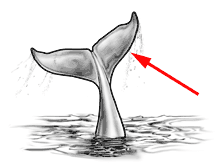 The tail fin (also called a caudal fin) of a whale or dolphin.
The tail fin (also called a caudal fin) of a whale or dolphin.When a cetacean holds their tail out of the water when they start to dive.
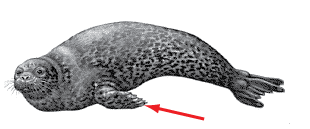 The pectoral flippers or front pair of flippers found on pinnipeds.
The pectoral flippers or front pair of flippers found on pinnipeds.In an animal, it is the width or area of the mouth when it is open.
A taxonomic category for a group of related plants or animals. The genus is the main subdivision of a family, and includes one or more species. For more information see the classification of animals.
The period of time when a mammal is pregnant.
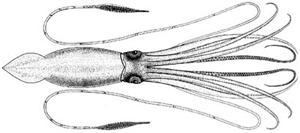 Members of the genus Architeuthis. Giant squids are large cephalopods. Large giant squids can reach up to 46 feet (14 meters) length and over 1000 pounds (450 kilograms). Average giant squid range from 20 to 40 feet (6-12 meters) in length and less than 1000 pounds. Sperm whales eat giant squids.
Members of the genus Architeuthis. Giant squids are large cephalopods. Large giant squids can reach up to 46 feet (14 meters) length and over 1000 pounds (450 kilograms). Average giant squid range from 20 to 40 feet (6-12 meters) in length and less than 1000 pounds. Sperm whales eat giant squids.Respiratory organs used by aquatic animals to extract oxygen from water. In some animals such as mussels, the gills also filter particles of food from the water.
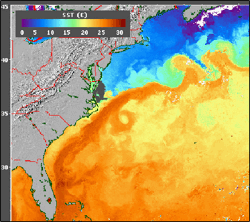 A current in the Atlantic Ocean that starts off the coast of Florida and moves northward along the east coast of the United States and then turns eastward toward Europe. This current provides a stream of warmer water along the coast and influences the climate in the eastern United States. (Image of the Sea Surface Temperature map, with the Gulf Stream showing in dark orange. Image by NASA).
A current in the Atlantic Ocean that starts off the coast of Florida and moves northward along the east coast of the United States and then turns eastward toward Europe. This current provides a stream of warmer water along the coast and influences the climate in the eastern United States. (Image of the Sea Surface Temperature map, with the Gulf Stream showing in dark orange. Image by NASA). The surroundings or locality where a plant or an animal is ordinarily found.
The deepest parts of the ocean, typically deeper than 20,000 ft (6,000 m).
A zone in the ocean where water salinity is not constant. Salinity in this area decreases with increasing depth. In the Atlantic Ocean, the halocline occurs from just below the well-mixed surface layer to about 3,300 ft (1,000 m).
A long spear-like tool used by whalers and fisherman. These tools typically have a pointed, barbed end and a rope or chain on the other end. Originally harpoons were hand-thrown and later mechanized or explosive harpoons were designed for whale hunting.
See herbivorous
Any animal that eats only plants.
A group of animals that stay together for a period of time.
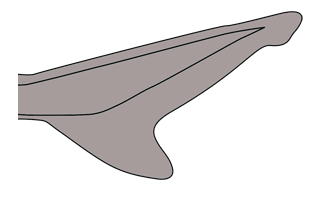 A tail of a fish or mammal that has a larger, longer upper lobe. This shape is typical in shark species.
A tail of a fish or mammal that has a larger, longer upper lobe. This shape is typical in shark species. The high seas are any part of the ocean or sea that does not belong to any state or nation. The high seas are also referred to as international waters.
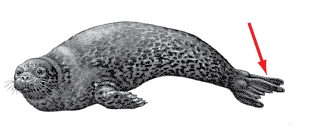 The rear flipper or pair of flippers on a pinniped.
The rear flipper or pair of flippers on a pinniped.Animals that are warm-blooded. All marine mammals are warm-blooded. Cetaceans use their layer of blubber and pinnipeds use their fur and blubber to help keep them warm.
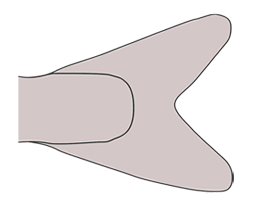 A tail of a fish or mammal that has two lobes of similar shape and size.
A tail of a fish or mammal that has two lobes of similar shape and size.A microphone used to record or listen to underwater sounds.
A crack deep in the ocean floor where hot water spills out. Water gets into cracks in areas where there is volcanic activity and is heated by the molten rock. This heated water rises and is forced out of the cracks creating plumes of mineral-rich, warm water deep in the ocean. These areas have unique species living around them.
I
A sound that is too low in frequency for humans to hear. These sounds are typically lower than 20 Hertz. Whale species produce sounds in the infrasound range.
A behavior when some species of whales discharge a cloud of reddish-brown waste that blurs the view of a potential predator, from which they then swim or dive away.
International Whaling Commission
(IWC). An international group designed to preserve whales and structure the international whaling industry (see IWC).
The area of the shore between where high and low tides occur.
J
The bones in the head of animals that support the teeth (or baleen) and form the mouth.
K
A ridge that runs lengthwise.
A grouping of diagnostic characters that can be used for quick identification. Scientists often use a specific type of key called a dichotomous key. In this type of key the diagnostic characters are grouped into couplets.
A measurement of speed in water. One knot is equal to one nautical mile per hour, or about 1.15 miles per hour (1.85 kilometers per hour).
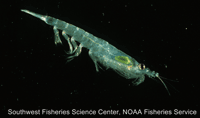 Members of the order Euphausiacea. These small crustaceans look like tiny shrimp and are also called euphausiids. They are a common food item for many cetaceans. Photo: Southwest Fisheries Science Center, NOAA Fisheries Service.
Members of the order Euphausiacea. These small crustaceans look like tiny shrimp and are also called euphausiids. They are a common food item for many cetaceans. Photo: Southwest Fisheries Science Center, NOAA Fisheries Service.Areas that circle the Earth and are defined as a certain distances from the equator. The equator is 0 degrees latitude. The Tropic of Capricorn and Tropic of Cancers are both around 23 degrees. The Arctic Circle and the Antarctic Circle are both around 66 degrees. Higher latitudes describe areas farther away from the equator.
A behavior where a cetacean slaps its fluke on the surface of the water.
A behavior in whales that occurs while they are resting. Individuals float at the surface, typically in large groups, all facing the same direction.
A method of commercial fishing, where lines and baited hooks are attached to a single main or long line. These longlines can be miles in length and set at a variety of depths.
Crescent or having a half-moon-shape.
A method of feeding used by baleen whales, where they lunge, or swim rapidly, through a group of prey with their mouths opened widely. This method allows them to take in a large amount of water and food rapidly.
A pair of organs that are used for breathing air in animals. They provide oxygen to the blood and remove carbon dioxide from the blood.
M
A class of vertebrates that have lungs, breathe air, are warm blooded, have hair at some time in their life, and have mammary glands that they use to nurse their young.
Mammals, one of the five classes of vertebrates. Species in this class have hair and nurse their young.
An organ found in mammals that produces milk. Young mammals drink the milk from these glands which help them live for the first stage of their life.
Members of the family Trichechidae. These species have have flattened, rounded tails, and eat mostly plants. They are found in the warm water of the tropics and subtropics. One species, Trichechus manatus, can be found in coastal areas and the freshwaters of the southeastern United States.
The jaw, especially the lower jaw, or any part that corresponds to this.
Things that are found in or made by the sea or ocean.
Mammals that live within the ocean or sea. Seals, walruses, whales, dolphins, porpoises, manatees, sea otter, and polar bears are some of the animals that are marine mammals.
(MMPA) The Marine Mammal Protection Act was passed by Congress in 1972. This Act gives protection to all marine mammals in the waters of the United States and prevents United States citizens from harming marine mammals or having or selling marine mammal products.
Materials that sink from upper layers of the ocean to the deep ocean create marine snow. This snow includes dead and dying zooplankton and phytoplankton, algae, sand, and other organic and inorganic materials. All of these falling materials add nutrients to the deeper layers of the ocean.
Anything connected to or associated with the sea.
When two or more marine mammals strand at the same time. This definition does not usually include mother and calf pairs.
(medial notch) A notch located on the middle of the fluke of a marine mammal.
(medial ridge) A ridge that runs along the middle of the head of a whale.
In toothed whales, dolphins and popoises, the melon is the area of the forehead that is fatty and often rounded in appearance. The melon is used in these species to help with echolocation.
The layer of the ocean that is from 660-3,280 feet (200-1,000 m) deep.
Toothed whales belonging to the genus Mesoplodon. Males of this genus commonly have large teeth that sometimes look like tusks that are visible coming out of their bottom jaws.
The movement of an animal from one area to another. Some marine mammal species migrate from feeding grounds in colder water areas to breeding and calving grounds in areas of warmer water.
See Marine Mammal Protection Act.
Small crustaceans in the order Mysidacea. These invertebrates look like shrimp and are food for some marine mammals.
One of two suborders of Cetecea (whales, dolphins, and porpoises) that include the baleen whales. Species occuring near the Georgia coast includes members of the the families: Balaenidae, Balaenopteridae, Neobalaenidae, and Eschrichtiidae.
N
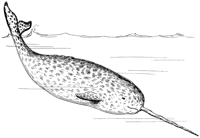 A whale species, Monodon monoceros, found in arctic waters. These whales gave a long spiralled tooth, that looks like a horn extending out the front of their head.
A whale species, Monodon monoceros, found in arctic waters. These whales gave a long spiralled tooth, that looks like a horn extending out the front of their head.The shallower coastal ocean waters that is located above the continental shelf.
The area on Earth that is north of the equator.
A V-shaped indentation near the middle of a whale's fluke.
The process of a mother mammal providing its young milk from its mammary glands.
O
Anything that is associated with the ocean. This typically includes the area of the deep ocean past the continental shelf.
One of two suborders of Cetecea (whales, dolphins, and porpoises) that include the toothed whales. Species occuring near the Georgia coast includes members of the the families: Delphinidae, Phocoenidae, Kogiidae, Physeteridae, and Ziphidae.
See omnivorous.
Describes an animal that eats both plant and animal material.
Taking advantage of the situation. An opportunistic feeder is one that will eat whenever food is available.
An animal that eats what ever food is available when it is feeding.
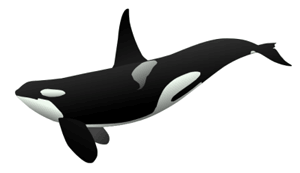 Orcas are one common name for killer whales (Orcinus orca).
Orcas are one common name for killer whales (Orcinus orca).A higher taxonomic category for a group of related animals or plants which share common characteristics. This category is more specific than a class and broader than a family. For more information see the classification of animals.
A group of contaminants typically used as a component of pesticides that can cause health concerns in both humans and animals. Some stranded marine mammals have had high levels of organochlorines.
A class of small crustaceans. They are also part of the zooplankton that live on or within the sea floor.
P
Distribution that cover the tropical regions world-wide.
Polychlorinated biphenyls or PCBs were used in the electrical industry as an insulator. PCBs are a type of organochloride and are toxic to both humans and animals. High levels of PCBs have been documented in some diseased and dieing marine mammals.
Fins, typically paired (one on each side of the body), located near the head. On marine mammals they are also referred to as flippers.
Paired flippers (one on each side of the body), located near the head of marine mammals. In pinnipeds, these are sometimes referred to as foreflippers.
The area of a fish, whale, or dolphin or other similar shaped animals between its tail and their body. This area is commonly narrower than the surrounding body or tail.
Deep ocean waters, open ocean, off of the continental shelf.
The process green plants and some other organisms (algae / phytoplankton) use to convert sunlight into energy.
The evolutionary history of any plant or animal species; the study of how a group of organisms evolved.
Small or microscopic photosynthetic organims that live near the surface of the water where light is available to create energy. This group includes diatoms, cyanobacteria, and some types of algae.
A group of marine mammals in the Order Carnivora that have flippers. The pinnipeds include all of the seals and walruses.
A behavior by dolphins where they leap out of the water with their whole body and land on their side, creating a large and loud splash.
An animal which eats plankton.
Very small photosynthetic organims (phytoplankton) and animals (zooplankton) that float or drift in fresh, brackish, or salt water. Plankton is a common food item for some marine mammals.
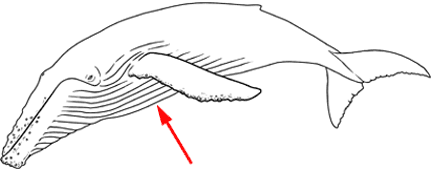 Pleats or grooves on the throat of baleen and some other species of whales. These pleats allow the throat to expand like an accordian, allowing these whales take large amounts of water into their mouths and throats (see ventral grooves).
Pleats or grooves on the throat of baleen and some other species of whales. These pleats allow the throat to expand like an accordian, allowing these whales take large amounts of water into their mouths and throats (see ventral grooves).With animals such as whales, dolphins, or porpoises, the term describes a family or social group that stays together; roughly equivalent to a flock or school.
A "cold-blooded" animal. See "ectotherm."
 The area close to the North Pole and the South Pole. The northern polar region is usually defined as the area above the Arctic Circle and the southern polar region usually include the continent of Antarctica and some of its surrounding waters (the area south of the Antarctic Circle). The polar regions are the coldest areas on Earth. Much of the water in the polar region stays as ice all year.
The area close to the North Pole and the South Pole. The northern polar region is usually defined as the area above the Arctic Circle and the southern polar region usually include the continent of Antarctica and some of its surrounding waters (the area south of the Antarctic Circle). The polar regions are the coldest areas on Earth. Much of the water in the polar region stays as ice all year.See PCB.
A group of small, toothed cetaceans that are similar to dolphins. Porpoises typically have a very short or no noticeable beak.
A behavior by small cetaceans, like dolphins and porpoises, where they quickly swim at the surface and jump out of the water. This may be a way for them to travel more quickly or use less energy.
An animal that captures other animals and eats them.
An animal that another hunts and eats for food.
Designates a species which cannot be legally trapped or hunted, usually because it is rare or of special conservation value. For more information see the conservation status.
A method of commercial fishing, where a large net that is weighted on the bottom and has floats on top is circled around a school of fish. The net is then pulled closed at the bottom (like an old-fashioned purse string), capturing anything inside of the net. Some species of dolphins are used to help "spot"" certain schools of fish and are accidentally captured in nets that are set on these schools."
R
When a group of marine mammals float near the surface together. This is usually done when individuals are resting. Another term for this behavior is called logging.
An algal bloom caused by species of phytoplankton, Karenia brevis, that caused a discoloration of the water to a brown or reddish-brown coloration. When this species blooms, it creates a natural toxin that can be hazardous to animals that become exposed to it. A red tide can also refer to other types of harmful algal blooms with a brown or reddish-brown coloration.
A general term for members of the family Balaenopteridae, including the genus Balaenoptera and humpback whales Megaptera novaeangliae. These species are all baleen whales which are characterized by having baleen and throat grooves.
The beak or snout of a marine mammal.
A behavior in dolphins of rapidly moving their tails as they make a high leap out of the water.
S
A patch of color located on the back and down the sides behind the dorsal fin of some cetaceans.
The formal nomenclatural designation of a taxon. Also called the taxonomic name. For more information see the classification of animals.
A form of artwork consisting of engraving on bone, including whale bone, baleen, or walrus tusks.
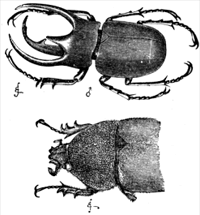 When males and females of the same species having two different forms, commonly in size, shape, or color. Some whale species have differences in the sizes of males and females. In the beaked whales, adult males have visible exposed teeth and the females do not. The image shows a male beetle (above) and a female (below) of the same species.
When males and females of the same species having two different forms, commonly in size, shape, or color. Some whale species have differences in the sizes of males and females. In the beaked whales, adult males have visible exposed teeth and the females do not. The image shows a male beetle (above) and a female (below) of the same species.The age (or size) when an animal is able to reproduce or have offspring.
When cetaceans are hit by ships traveling in the ocean. Ship strikes can cause severe injuries or death.
A feeding behavior performed by baleen whales, where they slowly move through the water with their mouths open while they constantly filter prey. Photo by Commander John Bortniak, NOAA Corps (ret.).
Sonar stands for Sound Navigation And Ranging. This is a method where a sound is produced underwater and used for navigation and communication.
A long series of vocalizations, usually with repeated sections. Bird song is usually given by males, although some females also sing. A song is used for recognition and territorial defense. Compare to calls, which are much shorter.
When a whale makes a deep dive.
The area on Earth that is south of the equator.
A conservation classification that designates a species that is not yet threatened but may be in the near future either because there are so few of them or their habitat is threatened. For more information see the conservation status.
A single distinct kind of plant or animal having certain distinguishing characteristics; a taxonomic category for a group of related organisms that form the largest unit of population within which effective gene flow occurs or could occur. For more information see the classification of animals.
An oil found in the spermaceti organ of sperm whales. This oil was highly sought after by commercial whalers.
A large organ (up to one-third the length of its body) in the head of sperm whales filled with a waxy oil named spermaceti. The function of the spermaceti organ is unknown.
A behavior of cetaceans when they exhale, blowing air up in a plume. This is also called a blow.
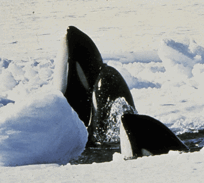 A behavior when a cetacean raises its head out of the water, possibly to look around, then sinks back below the water surface (Image by Commander John Bortniak, NOAA Corps (ret.)).
A behavior when a cetacean raises its head out of the water, possibly to look around, then sinks back below the water surface (Image by Commander John Bortniak, NOAA Corps (ret.)).Members of the class Cephalopoda. Squid have a main body, head, and paired tentacles. Squid are one of the main food sources of many toothed whales (Odontoceti).
A specific population of an animal that are defined for conservation and management.
When a marine mammal comes onto land either dead or alive (also termed beaching).
A division of a species. Different populations of a species, usually separated by different body coloration, vocalizations, and/or behaviors.
Two zones around the globe. One in the northern hemispehere above the tropics and one in the southern hemisphere below the tropics. This zone has cooler ocean temperatures than the tropic zone.
One of two or more different names applied to one and the same taxon.
The study of the evolutionary relationships between living organisms.
T
On a cetacean, the generally narrow area from behind the dorsal fin to the tail, also referred to as the caudal peduncle.
See taxon.
Any one of the categories used in naming and classifying organisms, including phylum, class, order, family, genus, and species. For more information see the classification of animals.
The science of classification of organisms on the basis of their supposed evolutionary relationships. For more information see the classification of animals.
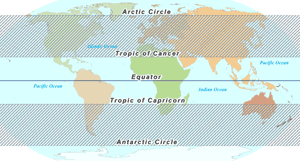 The regions on Earth, where there are four distinct seasons, and the air temperatures are commonly above 50 degrees F (10 degrees C) for at least four months out of a year. In the northern hemisphere, the temperate zone occurs between the Tropic of Cancer north to the Arctic Circle. In the southern hemisphere, the temperate zone occures between the Tropic of Capricorn south to the Antarctic Circle.
The regions on Earth, where there are four distinct seasons, and the air temperatures are commonly above 50 degrees F (10 degrees C) for at least four months out of a year. In the northern hemisphere, the temperate zone occurs between the Tropic of Cancer north to the Arctic Circle. In the southern hemisphere, the temperate zone occures between the Tropic of Capricorn south to the Antarctic Circle.An area in the ocean where there is a distinct change in the water temperature as you change depth.
Describes a species of animal that is not endangered but may become so in the near future. For more information see the conservation status.
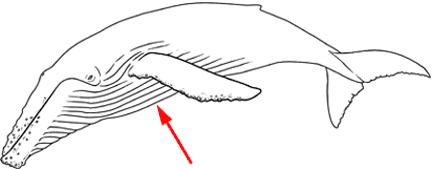 Pleats or grooves on the throat of baleen and some other species of whales. These pleats allow the throat to expand like an accordian, letting these whales take large amounts of water into their throats (see pleats).
Pleats or grooves on the throat of baleen and some other species of whales. These pleats allow the throat to expand like an accordian, letting these whales take large amounts of water into their throats (see pleats). Pleats or grooves on the throat of baleen and some other species of whales. These pleats allow the throat to expand like an accordian, letting these whales take large amounts of water into their throats (see pleats).
Pleats or grooves on the throat of baleen and some other species of whales. These pleats allow the throat to expand like an accordian, letting these whales take large amounts of water into their throats (see pleats).The change in the level of the ocean created by the gravitational forces of the moon and sun on the Earth.
One of two suborders of Cetecea (Odontoceti). These whales have teeth and commonly eat squid, fish, and other marine mammals. Species of toothed whales that occur near the Georgia coast includes members of the the families: Delphinidae, Phocoenidae, Kogiidae, Physeteridae, and Ziphidae.
An oil, also called whale oil, which is created from the blubber of whales and also from the spermaceti organ in the head of sperm whales. Whale oil was harvested for use in oil lamps, lubricating machinery, and creating soap and margarine.
A method of commerical fishing where a net is pulled behind one or more boats to capture fish.
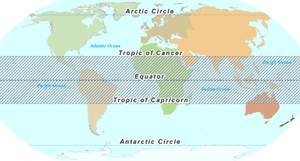 The region of Earth near the equator, below the tropic of Cancer in the northern hemisphere and above the tropic of Capricorn in the southern hemisphere. This region has warmer ocean temperatures than other places around the globe. Some whale species use the tropics for breeding and calving grounds.
The region of Earth near the equator, below the tropic of Cancer in the northern hemisphere and above the tropic of Capricorn in the southern hemisphere. This region has warmer ocean temperatures than other places around the globe. Some whale species use the tropics for breeding and calving grounds.Bumps found on the head, body, flippers, and tails of some cetaceans. Humpback whales have tubercles on their head, each one with one or more vibrassae.
Bumps found on the head, body, flippers, and tails of some cetaceans. Humpback whales have tubercles on their head, each one with one or more vibrassae.
(TED). A device attached to a net that allows a sea turtle to escape after being caught. These devices were made to try to decrease the number of sea turtles that die as commercial fishing by-catch.
U
An area in the ocean typically found near the coast, where cooler, more nutrient-rich water is pushed toward the surface and replaces the warmer, nutrient-poor water. These areas tend to provide a lot of food for fish and other animals in the ocean.
V
An external opening at the end of the excretory tract. Also called an anal opening or cloaca.
See ventral.
Having to do with the under side of a cetacean or pinniped.
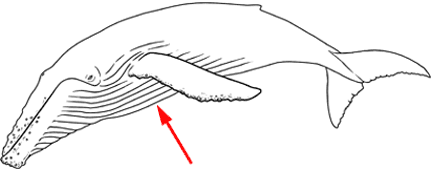 Pleats or grooves on the throat of baleen and some other species of whales. These pleats allow the throat to expand like an accordian, letting these whales take large amounts of water into their mouths and throat (see pleats).
Pleats or grooves on the throat of baleen and some other species of whales. These pleats allow the throat to expand like an accordian, letting these whales take large amounts of water into their mouths and throat (see pleats).See ventral.
An animal that has an internal bone skeleton.
Describes a part of an animal (such as an organ or bone) that is no longer used by the species and has therefore become smaller or less developed.
Specialized hairs or whiskers that are used as sensory organs.
In animals, when young develop inside the body of their mothers and they are born live. Mammals are viviparous.
W
When a mother stops nursing their young, and their young have to start capturing their own food.
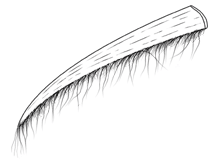 Plates of hard, flexible keratin with flexible fringes that hang from the upper jaws of certain types of whales. Baleen whales use these plates to filter food, see baleen.
Plates of hard, flexible keratin with flexible fringes that hang from the upper jaws of certain types of whales. Baleen whales use these plates to filter food, see baleen.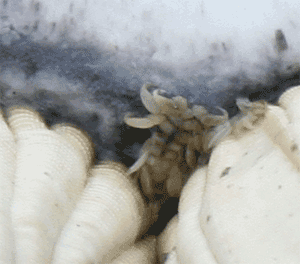 Members of the family Cyamidae. These tiny crustaceans live on whales, dolphins, and porpoises. They eat the skin of the animals on which they live. Photo: Aleria Jensen, NOAA/NMFS/AKFSC.
Members of the family Cyamidae. These tiny crustaceans live on whales, dolphins, and porpoises. They eat the skin of the animals on which they live. Photo: Aleria Jensen, NOAA/NMFS/AKFSC.An oil, also called train oil, which is created from the blubber of whales and also from the spermaceti organ in the head of sperm whales. Whale oil was harvested for use in oil lamps, lubricating machinery, and creating soap and margarine.
Z
Small or microscopic organisms found in water that drift or have limited ability to swim. Zooplankton include copepods, krill (eupausiids), and larval fish and squid.

 Marine Mammals of Georgia
Marine Mammals of Georgia